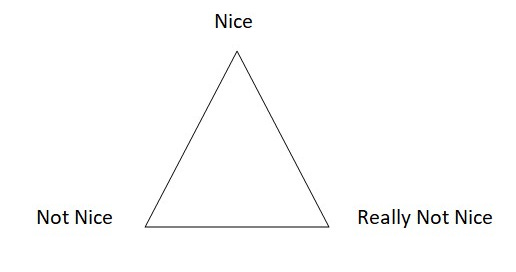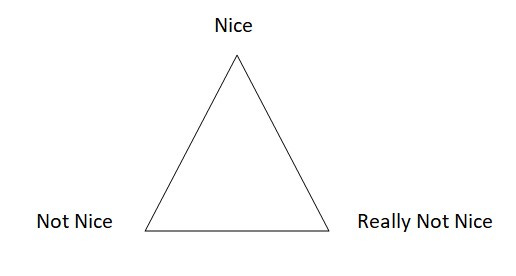In today’s posting, I’d like to provide you with some imagery that will hopefully be something you can refer back to in the future. Indeed, moving forward, I think that I’ll call this “Imagery Thursday.” Mark your calendars in anticipation and for that matter, I’ll call Tuesday, “Science Tuesday,” as I’d like focus that day on research. Also, stay tuned as I’ll be introducing a third component of the blog more focused on opinion and editorial. I think I’ll call it “Discord Sunday.”
The image I’d like to introduce today is the Conflict Triangle. On a piece of paper please draw, you guessed it, a triangle. Next to each of the bottom two corners of the triangle, write the word “calm” or some other word that conveys a sense of calm. Words like “peaceful,” “constructive,” or “proactive” would work just fine. At the top of the triangle, write the word “angry” or another word that conveys anger or an animated state. Something like “abrasive,” “insulting or “reactionary” would be good choices. The point of the image is this: when we are in a calm, proactive, reasonable state and we are having a discussion or even a debate with another individual or group that is in the same state, or for the purposes of our imagery, at the base of the triangle, we are state of what I refer to as “widening,” and widening is a very good place to be. The suggestion is that we are promoting an open mind to other ideas and that we are using a non-abrasive tone. It certainly means that we are not being insulting to the other party. This is a state where, at a minimum, we are receptive to and are learning about the other party’s position. We are not discounting the value of that party’s position simply because it doesn’t agree with our own. The wide part of the triangle is where progress is made and most often it is fueled by empathy. At the top of the triangle, we are in a state of what I call “narrowing” and narrowing is not a good place to be. Narrowing, as the word suggests, is limiting. It closes the door to other ideas. It is usually fraught with aggravated emotions and ego. It is reactionary and it rarely leads to anything productive. The salient point is this: to the best of your ability, always try to stay at the bottom of the triangle and in a widening posture. Do your best not to get lured to the top of the triangle. It is an incredibly difficult thing to do, but how many times have you actually seen a heated, angry, reactionary conversation go anywhere other than both parties feeling worse afterwards and wishing that cooler heads prevailed? I did a lecture a while back at a large company and one of the participants asked me “what do I do when my boss is angry and shouting at me?” My answer was that unless you have both agreed that angry, shouting and narrow is an acceptable part of your working relationship, then a) that behavior is not appropriate especially coming from a leader, and b) do not engage, remain calm and if needed, ask that the discussion continue later. Again, it is incredibly difficult to be the party to remain calm but stand firm and it’s absolutely your right to do so. It’s not good enough for someone to say, I’m an angry, emotional person and every once in a while or more often, I’m going to point that at you and I’d like you to be OK with it. No, that’s not OK and it’s especially not OK from a person in a position of power. Draw the Conflict Triangle on a Post It Note or something that you can hang on your wall, refrigerator or somewhere where you will have ready access to it. I think you’ll find it useful in the next interaction you have that has the potential to turn to conflict
.




